Venus flytraps have evolved to be successful predators. In this article, I would like to answer a common question about these amazing plants: How do Venus fly trap work? I have grown carnivorous plants for a few years and enjoy learning about their adaptations. This article describes the predatory and reproductive mechanisms of these plants.
Venus flytraps lure prey inside their traps by producing sweet nectar. If the victim comes in contact with the trigger hairs inside the trap, the lobes close. The victim can try to escape, but the movement provokes the plant’s enzyme production. The enzymes digest the insect, and the leaf absorbs valuable nutrients.
Now, let’s explore the inner working mechanisms of the Venus flytrap to capture and digest prey. In the next sections, you can also learn about reproduction and the origin of carnivorous plants.
How Venus Flytrap Capture and Digest Prey
Venus flytraps are native to only one region in the world. They grow natively in South Carolina and North Carolina in the United States. They only live in those two states, and they are present in wetlands and sandhills.
In their natural habitat, Venus flytrap have plenty of access to sunlight and water, but the soil they grow in is very poor. The ground in nutrient less. Venus flytraps have evolved to adapt to this environment. They produce food through photosynthesis but are unable to gather key nutrients (usually found in the soil) to supplement their diet. As a result, Venus flytraps have evolved to capture insects. The prey they capture provides elements such as Nitrogen, Phosphorus, Sulfur, and Potassium.
Sometimes Venus fly traps won’t close their leaves to capture insects because they might be hibernating or sick. in this article you can find more info on this: Why Venus Fly Traps Won’t Close Plus Easy Fixes.
Suitable Prey
Venus flytrap can consume many different types of prey. Their diet is not restricted to only flies. Venus fly traps often capture slugs, ants, gnats, beetles, grasshoppers, crickets, caterpillars, spiders, and many other arthropods. But Venus flytraps are not insectivorous plants, they are carnivorous plants.
Venus flytraps can consume meat. On rare occasions, large Venus flytraps capture tiny frogs, very small rodents of birds and the plant is able to absorb nutrients from those victims too. Still, these occurrences are rather rare.
Venus flytraps are small plants; mature Venus flytraps reach an average trap size of one inch. At that scale, capturing bugs is much more appropriate. Venus flytraps evolved to capture prey. But they did not grow enormously large traps to capture large animals. They kept a small scale, as they can extract all the necessary nutrients from small insects and spiders.
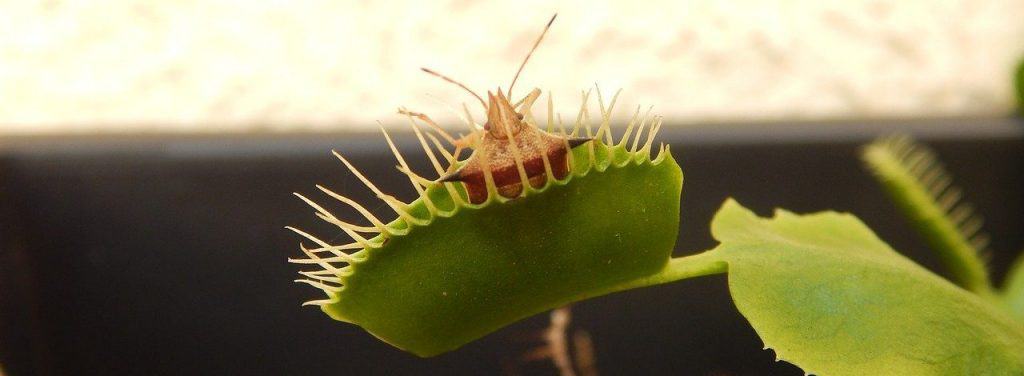
How Venus Flytrap Attract Their Prey
Venus flytraps have modified leaves which act as trapping mechanisms. Each leaf has a petiole section connects to the jaw like structures we call traps. The trap is made up of two lobes.
The colors and scents of the plant are critical to lure potential prey. Venus flytraps exhibit bright green and red colors. Some specific varieties are completely green or completely red. However, those specimens were created in a controlled setting. The standard Venus flytrap is it its majority green. But, the interior of its trap is bright red.
The red color inside the traps mimics the scheme of a flower. Besides the color, Venus flytraps produce sweet nectar inside those traps. Insects get lured to the nectar with a sense of safety, as it resembles a harmless flower.
The Venus Flytrap Trapping Mechanism
Each lobe in a Venus flytrap leaf contains three trigger hairs. Those trigger hairs are arranged in a triangular pattern close to the center of the trap.
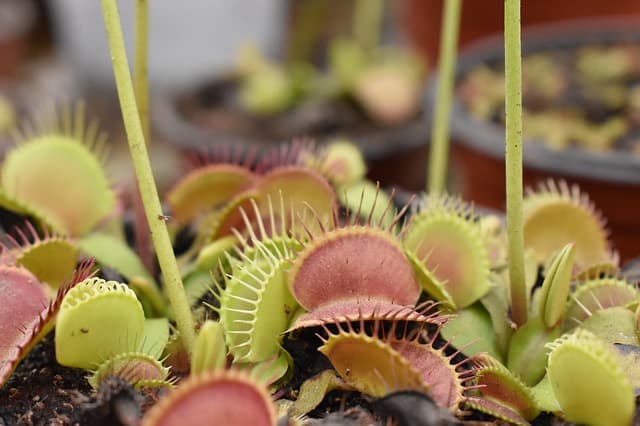
When a bug arrives at the trap, it starts consuming sweet nectar. As it moves inside the trap, it might come in contact with those trigger hairs. If the bug stimulates those trigger hairs twice within a short period, then the plant closes. This mechanism is called the double stimuli.
Double Stimuli
The Venus flytrap developed the double stimuli mechanism to avoid closing without reasonable cause. In the wild, Venus flytraps are in contact with the environment. They withstand challenging conditions such as storms, snowfall, and gusty winds. Sometimes rainwater, a twig, a leaf, or any inanimate object can come in contact with those trigger hairs. But, for the plant’s benefits, the traps should not close unless there is a potential victim.
Venus flytraps employ large amounts of energy, activating their traps. The double stimuli mechanism is critical to saving the plant’s energy and livelihood. Each leaf requires two consecutive stimuli to close.
Closing in Two Stages
After the appropriate stimuli, a trap closes in a snap of a second, hopefully (for the plant) capturing the victim. The lobes come together while the cilia in intertwined, but the leaf if not wholly shut at first. The traps close in two stages:
First, the lobes come together, but they do not close completely. The victim can see the exterior or maybe scape if it is small enough to scape in between the cilia, which look like prison bars. At this point, the plant is waiting for further stimuli. Further stimuli take the plant to stage two of its trapping mechanism. Venus flytraps do not consume dead bugs. Their objective is to capture a suitable living victim. Without further stimuli, the plant abandons the effect to consume a bug and reopens.
After receiving further stimuli, the trap closes completely. The cilia continuos to be intertwined, but this time the lobes are sealed airtight. The airtight enclose it critical to keep bacteria out of the digestion process.
Sometimes Venus fly traps will remain closed after capturing a bug for a long period or might never open back up. This article explains why venus fly traps won’t reopen. Spoiler: it is usually due to improper feeding.
Prey Selection
Scientists hypothesize Venus flytraps select their prey based on size. They believe one of the reasons why Venus flytraps close in two stages is to release tiny bugs. When a victim is too small, it might not be worth going through the whole digestion process. Even though prey selection is not a proven concept for Venus flytraps, some experiments indicate some promising evidence.
“Among carnivorous plants, the Venus flytrap is of particular interest for the rapid movement of its snap-traps and hypothesized prey selection, where small prey are allowed to escape from the traps (…) ” Understanding the Venus flytrap through mathematical modeling, Sami Lehtinen
Fast Motion
How do Venus flytraps close so fast? The Venus flytrap exhibits one of the fastest motions of the plant kingdom. It is only possible to observe the trapping mechanism in detail with a slow-motion camera.
Initially, while resting, the lobes in the traps are in a convex position (like a hill). Then, once the leaf receives specific electrical signals, the lobes go from convex to concave (a valley). The trap can close at such a high speed due to its shape. In simple terms, the leaves can achieve such fast motion because they work like this kids toy: the rubber poppers (here are some pictures just in case you are unfamiliar with it).
Flytrap Digestion Explained
After a trap has closed completely, the digestion can start. At this point, the victim is still alive, but not for long. The lobes of the trap contain special glands that produce enzymes; the enzymes are meant to break up the insect. As the insect continues to generate stimuli, the special glands produce enzymes.
The enzymes start pumping into the leaves until the trap is filled complexly. The bug eventually dies drowned in the enzymes and the plant starts breaking up the body and absorbing nutrients. The enzymes are able to break up all the soft parts, of the insect, but it takes a long time.
Venus flytraps take one to two weeks to digest one single insect. The traps act as external stomachs. They break up the prey with enzymes and absorb the nutrients. Then, after the plant has finished, the trap reopens. In most cases, you can observe some of the remains of the victim. The enzymes in the leaves can break up the soft tissue of the bug, but it is unable to consume the exoskeleton. In the wild, the bug pieces wash off or get blown up by the rain or wind.
Feeding and Photosynthesis
The feeding process is important for the plant’s development but is it not critical. Venus flytraps capture bugs and absorb key nutrients to supplement their diet. However, Venus fly traps exist due to photosynthesis. Like other plants, carnivorous plants also produce their own food. They do not need to capture bugs to survive as they can live happily producing their own food through photosynthesis.
Consuming bugs boost the plant’s diet and encourages growth but is not a necessity. Also, Venus flytraps do not need to consume large amounts of bugs to exhibit positive effects. Consuming a single bug once a month or once every few months is enough for the plant.
Curious Color Changes
Venus flytraps have a unique characteristic; they change color based on their necessity. Most Venus flytraps you see in photos characterize by bright green and burgundy colors. However, this coloring scheme can change. For example, the red coloring in the traps can fade.
One of the main requirements for growing Venus flytraps is access to plenty of sunlight. In optimal conditions, Venus flytraps should receive 12 hours of sunlight every day. These plants require light to produce fuel through photosynthesis. Without appropriate lighting, Venus flytraps are unable to develop correctly. When Venus flytraps are not receiving enough lighting, they lose the red color inside the trap. The red might fade or disappear altogether. The changes are more apparent in new leaves.
The increase in green coloring is the plant’s defense mechanism. Without the red lobes, the plant has a larger green section focused on photosynthesis. But the color changes are not permanents. When the plant starts receiving appropriate lighting, the lobes will start regaining the red pigment.
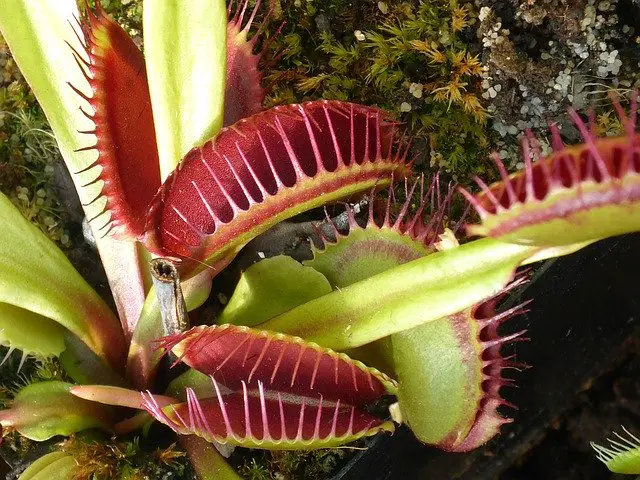
Bright red lobes are a sign of health. The plant has plenty of access to light, and it is ready to focus on its second priority: capturing bugs.
The color changes described in this section are commonly observed on Venus flytraps. However, some specific varieties of Venus flytraps do not experience any color change. Some types are already entirely green, and others are entirely red. Besides, some Venus flytrap varieties are known for exhibiting very bright colors, especially in the lobes. Others have more soft colors.
Venus Flytrap Reproduction Mechanisms
Venus flytraps reproduce through multiple methods.
Venus flytrap can propagate through flower pollination, bulb divisions, leaf cuttings, and stalk cuttings. The first two methods occur in the wild without any help from humans.
This section will cover two of these methods: flower pollination and bulb divisions. The other two methods are explained in this article: How Do Venus Flytrap Reproduce? – 4 Propagation Methods. Make sure to read it if you are interested in Venus flytrap propagation.
Flower Pollination
In the spring, mature Venus flytrap produce flowers for reproduction. Like other plants, they rely on pollinators to fertilize the flowers and produce seeds.
Have you ever wondered how do Venus flytrap flowers get pollinated? What happens if the Venus flytrap eats the pollinating insects instead? Wind and rain also fulfill the role of pollinators. But what about insects. Is it safe for them to pollinate those flowers?
The flowers of Venus flytraps do get pollinated by insects. The plant had adapted to provide a welcoming environment for potential pollinators. Generally, the plant avoids consuming pollinators.
Observing a Venus flytrap during the flowering process is unique. You do not only have the majestic traps but now you also have pretty flowers. The flowers and the leaves give a fantastic look, but they are not close together. The traps stay close to the ground. The flower stalks, on the other hand, grow tall way above the traps, as shown in the picture below.
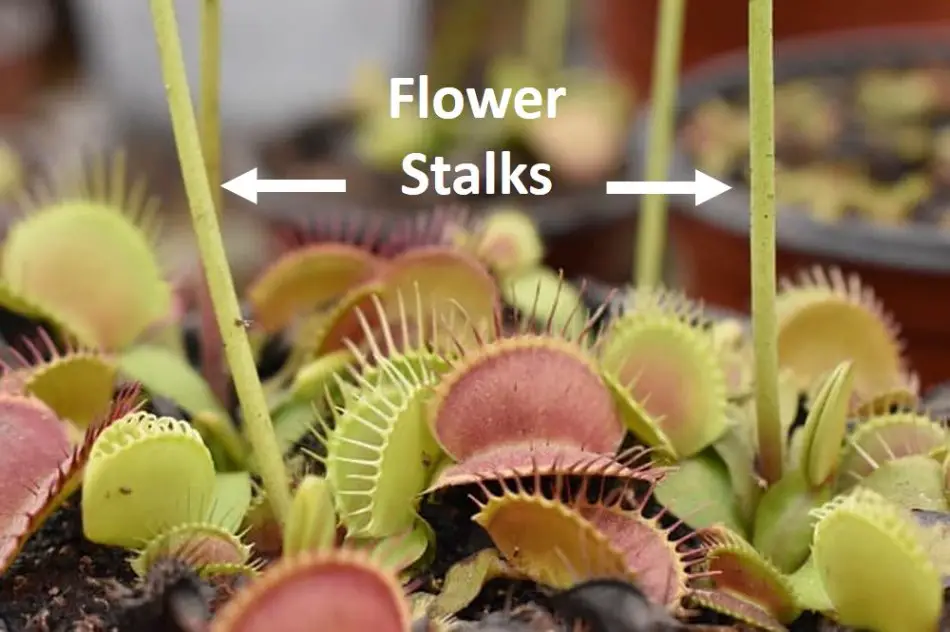
Rhizome Division
Venus flytraps also propagate through rhizome division, which is a type of vegetative reproduction. In the spring or early summer, a mature plant can extend its roots and create a bulb root that eventually separates from the parent and becomes a new plant. The new plants arising from rhizome divisions are exact clones from the parents. A single Venus flytrap can propagate multiple times every season, creating dozens of clones after just a few years.
Generally, Venus flytraps have 3 to 7 healthy leaves at a time. A plant that exhibits more than seven leaves might not be a single plant anymore. It can easily be two or a full set of Venus flytraps.
Venus flytrap owners can separate the plants and let them grow independently. The short video below shows a few clips from a Venus flytrap I own. The plant had propagated multiple times. Since the pot was not big enough to hold all the divisions, I decided to divide them and ended up with seven independent plants.
In the wild, Venus flytraps propagate through rhizome divisions, and they produce multiple clones. Even though their roots are independent, most clones end up growing very close to the parent.
The Dormancy Period
Many carnivorous plants require a dormancy period every year. Venus flytraps are one of them. During the winter, Venus flytraps go dormant for 2 to 4 months.
The dormancy period is a resting period similar to hibernation. During dormancy, Venus flytraps change substantially. They lose several leaves, and the plant shrinks in size. Also, their growth stops completely as their main focus is not on growing overground. Instead, the plants focused on strengthening the root system.
In the wild, Venus flytraps enter dormancy in late October or November as the temperatures drop. The plants enter dormancy when exposed to temperatures below 45 F (7 C) for a few weeks. The plant remains dormancy for the next couple of months until the temperatures start rising. Once the temperatures rise in late January of February, the plant exits dormancy.
In the spring, right out of dormancy, the plant will start proliferating. The plant is recharged and ready to start producing new leaves and reproduce.
The dormancy period is essential for Venus flytraps. In their natural habitat, they do not have any issues entering and exiting dormancy. However, in other locations, Venus flytraps need exposure to cool temperatures to experience dormancy every year.
Venus flytraps must go dormant every year. A plant can skip dormancy, and it will be ok. But, skipping dormancy several years in a row will shorten the plant’s life expectancy. Venus flytraps can live for over 20 years with proper dormancy. Without it, they perish after only a couple of years.
How Venus flytrap Work at Home
The Venus flytrap is the best known carnivorous plant. People all over the world own them and research their unique characteristics. In this section, I will explain how Venus flytraps grow at home.
Technically Venus flytraps can be grown outdoors or indoors as long as they have access to some essential elements:
- Lighting: At least 6 hours of sunlight (or artificial light)
- Soil: Carnivorous plant soil to grow
- Water: The plant must be continuously watered with rainwater, distilled water, or reverse osmosis water to keep a moist environment.
- Comfortable temperature between 32 F and 95 F (0 C and 35 C)
- Cold winters for dormancy: Temperatures below 45 F (7 C) for at least a couple of months
To grow a healthy Venus flytrap, owners must attempt to mimic the natural habitat of the plant at home. First, Venus flytraps are unable to handle minerals or nutrients in the ground or water. It is essential to employ nutrient-free carnivorous plant soil and only employ pure water such as distilled water, reverse osmosis water, or rainwater. Venus flytraps can adapt to a wide range of temperatures and humidity levels. However, they prefer high humidity environments.
Growing Venus flytraps outdoors is much easier as they can have plenty of access to sunlight and possibly reasonable amounts of water through rainfall. Also, in the outdoors, Venus flytraps capture their prey which, as we learned, is not a requirement but can boost the plant’s growth substantially.
It is possible to grow Venus flytraps indoors. However, it is a challenge. The indoor location must have access to natural light, or the owner must build a plant light setup. Also, inside a temperature-controlled environment, the plant won’t achieve dormancy during the winter. Venus flytraps can achieve dormancy indoors, but they need exposure to cool temperatures. Therefore, most people usually place them in a cold basement, porch, or garage.
If you are interested in growing Venus flytraps, make sure you learn about the care considerations for these plants. You can download a complete Venus flytrap care sheet and read an article about it HERE.
Venus Flytraps as Bug Controllers
Venus flytraps capture bugs outdoors and indoors; it all depends on the insect availability.
Indoors or in greenhouses, carnivorous plants can act as a bug controller. However, Venus flytraps are not the most effective candidates. Venus flytraps only have 3 to 7 healthy traps at a time. They can only capture a maximum of half a dozen bugs at a time. Then, the plant takes a few weeks to digest the insects. Venus flytraps can lower the bug population at home, but they won’t get rid of a plague. Pitcher plants and sticky trap carnivorous plants are more effective in controlling bug plagues.
Large Pitcher plants can hold large amounts of bugs in a single pitcher and act as a bug controller. Carnivorous plants with adhesive traps are also highly effective. For example, the Butterworts and Sundews can capture dozens of bugs at a time.
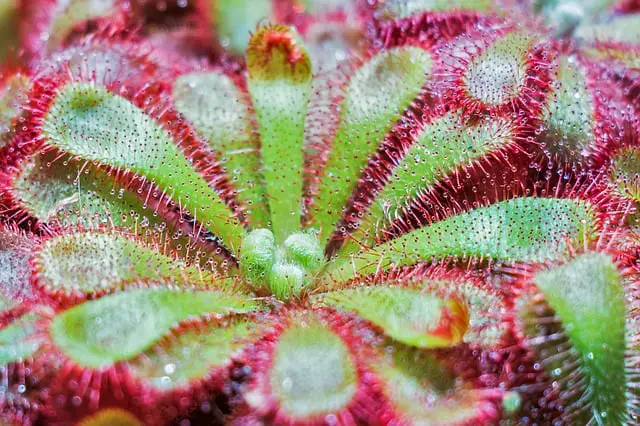
Are Venus Flytraps Dangerous?
Venus flytraps pose no harm to humans. They are not poisonous, and they are even edible. Not sure who will eat them, but they are safe. In terms of their jaw-like leaves, the traps in Venus flytraps are too small and weak to harm humans. You can stick your finger inside a Venus flytrap to feel the pressure, but you won’t be very impressed. The trap closes, and you will feel it, but the pressure is not enough to keep you stuck to the plant. Technically, Venus flytraps can consume human flesh. But, due to their size, they can’t consume large animals.
Venus flytraps are not toxic to cats or dogs either. They can get indigestion after eating a Venus flytrap, but nothing else. As a recommendation, place Venus flytrap away from pets. Cats and dogs are sometimes curious about them and might eat them or harm them.
Humans shouldn’t be concern about Venus flytraps being dangerous. On the other hand, humans pose a significant danger to Venus flytraps. They are an endangered species. Their natural habitat has changed substantially over the past decades, and unfortunately, the native population is in decline. Also, Venus flytraps are endangered due to poachers. People in the area remove Venus flytraps from the wild to profit from selling them. Many nurseries and shops grow Venus flytraps in a responsible matter. But, unfortunately, poachers have excessively remove Venus flytraps from the wild, and the population is soaring.
Origins of the Carnivorous Nature
Venus flytraps are only native to a particular area. They grow in the states of North Carolina and South Carolina. There they only grow in two regions: the coastal plain and sandhills. Their natural habitat characterizes by inferior soil. Consistent rainfall and sandy grounds drain the nutrients in the earth.
Species of carnivorous plants have developed independently all over the world. They grow in areas that are characterized by a lack of nutrients. Scientists hypothesis carnivorous plants settled in nutrition-less environments due to the lack of competition. In those environments, carnivorous plants had the space to develop and thrive. However, they have evolved to survive. Instead of extracting nutrients from the soil, carnivorous plants, like Venus flytraps, capture bugs. The insects they consume provide all the nutrients lacking in the ground.
Venus flytraps are not the only plants that develop a carnivorous behavior. The Pitcher plant, Sundew, Sarracenia, and Butterwort are also carnivorous plants.
Related Questions
Why is a trap not closing after receiving stimuli?
The traps should close after receiving stimuli. However, two factors can prevent it from closing: The trap is dying or dormancy. The leaves open and close only a certain number of times before they wither. At some point, they will start to dry out. Sometimes it is not apparent than the leaf is drying, but eventually, it will start turning black.
Sometimes traps do not function during dormancy. Venus flytraps have a resting period during dormancy. During this time, the plant is not focused on capturing bugs. The plant loses part of its leaves and the remaining ones might not work for a few months.
Why is a trap closed? And when will it reopen?
A trap closes when it receives the appropriate stimuli. Once closed, the trap might be digesting a bug, or maybe it was unsuccessful at capturing prey, and it is empty. When a Venus flytrap captures prey, it will digest it. It will take several days or even weeks to consume the bug. During digestion, the trap will remain closed at all times. It will only reopen when it is finished.
Sometimes Venus flytraps close, but they will reopen without digesting anything. Maybe the bug scape, or perhaps the trap closed due to an inanimate object activating the lobes. In these scenarios, the plant won’t proceed to digest anything. Instead, it will reopen. There is no exact time, but usually, within 24-48 hours, the plant reopens.
How many times can a trap close?
The traps have a life expectancy limitation. Once a trap has been activated a certain number of times (between 5 and 10), it will reach its life expectancy. Then, the trap withers. This process is normal. Every time a trap withers, a new leaf should be growing from the center of the bulb as a replacement.
For this reason, it is crucial to avoid triggering the traps of the plant unless it is for feeding. Playing with the lobes speeds up the withering process and causes the plant to lose leaves.
Can Venus flytrap consume dead bugs?
In the wild, Venus flytraps do not consume dead bugs, but humans can successfully feed dead insects to Venus flytraps. The problem with dead feed it’s the lack of movement. Venus flytraps reject prey that does not cause any stimuli. However, a method has been developed to feed dead bugs to these plants.
People all other the world own Venus flytraps, and growing them indoors is a common option. Employing dead bugs to feed a Venus flytrap is a practical solution. Also, life and dead prey provide almost the same amount of nutrients; they are both suitable options from a health standpoint.
To feed dead bugs to Venus flytraps, the owner must introduce the bug in the trap and activate the lobes by touching the trigger hairs. The trap will close, but it can lose interest without further stimuli. A way to go around it is to use your fingers or a tool to press the sides of the trap multiple times. Eventually, the plant will close entirely and start producing enzymes as it has been tricked into consuming a dead bug.
Feeding Venus flytraps improperly can harm the plant. This guide can teach you how to feed a Venus flytrap, step by step:
Do Venus flytraps bite?
Venus flytraps do not have teeth; they do not bite. The cilia surrounding the traps of Venus flytraps are not teeth or anything meant to chew the victim. Instead, they play a crucial role in locking the lobes. Venus flytraps consume their prey by trapping them inside their leaves. Then, they produce digestive enzymes to break up the bug.
If you stick your finger inside a trap and it closes, you could say the plant bit you. But, in reality, the leaves are more of a stomach than a mouth.
Can Venus flytrap eat human food?
Venus flytraps can digest complex organisms. However, they are not designed to consume human food. It is a big misconception that Venus flytraps can be fed with any food. In the wild, their diet is solely based on bugs. You can introduce human food in a trap and start the digestion process. However, it won’t provide much benefit. The plant will struggle to digest the food. The leaf will likely begin to wither due to the strain, and the food will rot inside a dried-up leaf. And this can cause problems. Rotting food can attract bacteria and mold.
Always abstain from feeding human food to Venus flytraps; do not feed them fruit, candy, chicken, ground beef, hamburger, bread. Instead, stick to an insect-based diet.


